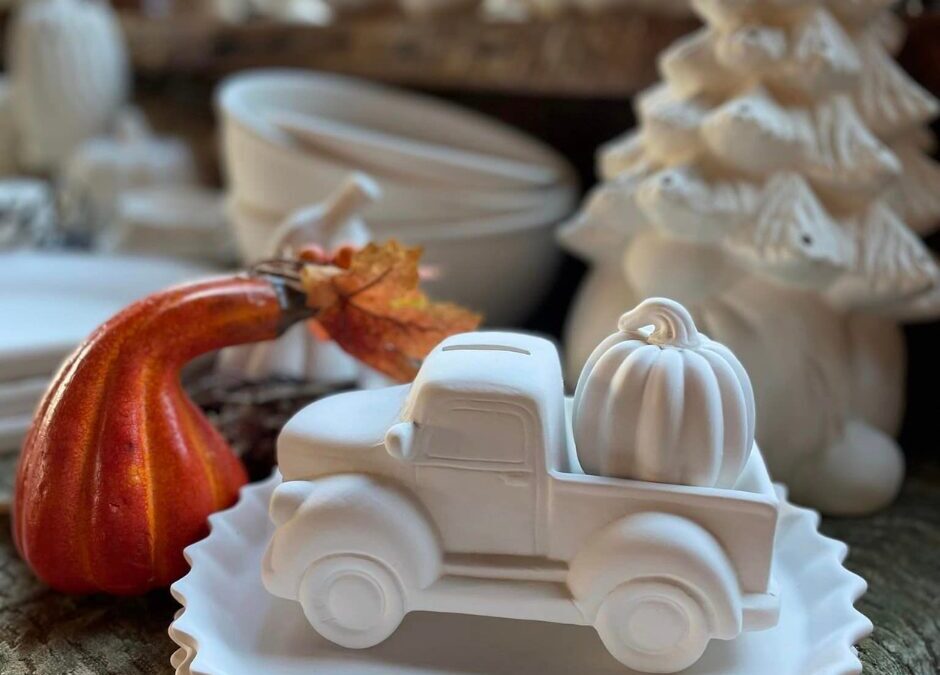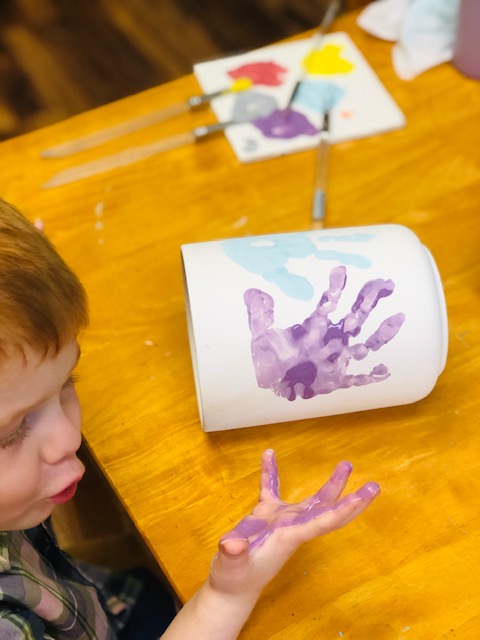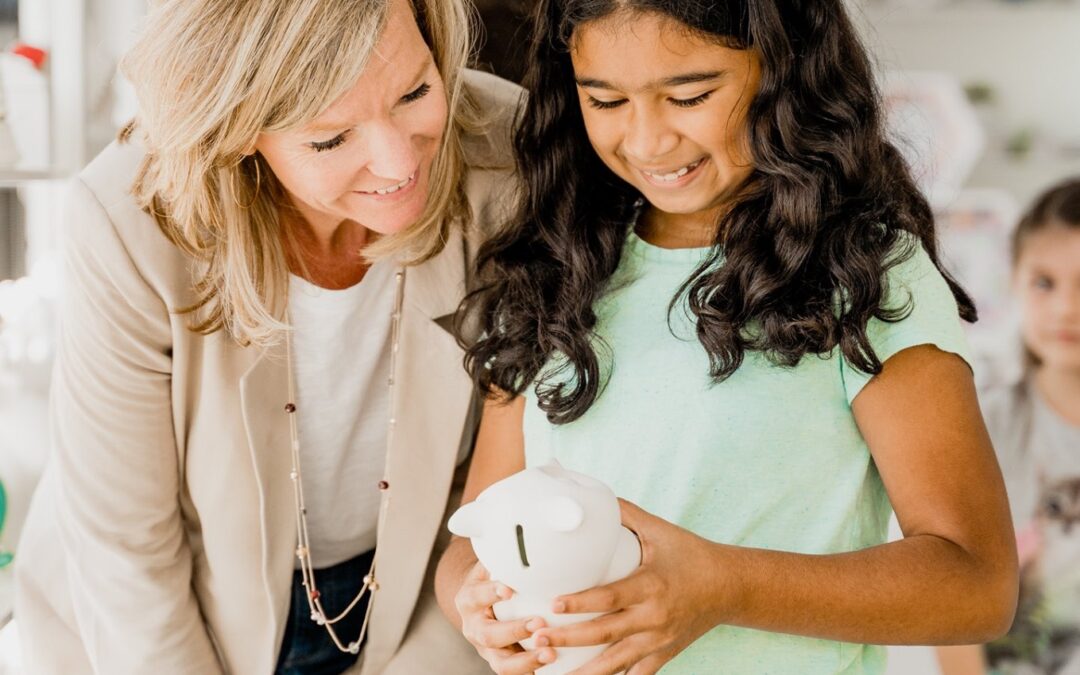
by CCSA Admin | Oct 15, 2024 | Blog
Are you looking for a unique, meaningful gift for someone special this holiday season? Imagine not only creating a thoughtful, handmade piece but also unwinding during the process. This year, treat yourself to a relaxing paint-your-own pottery (PYOP) session, and check off one gift on your shopping list!
After years of constant decision-making and limited normalcy, it’s time to embrace some much-needed calm. Painting pottery offers a creative outlet that helps you de-stress while crafting a personalized gift for someone you’re thankful for. Whether you prefer a guided seasonal class or enjoy the freedom of painting on your own in a cozy studio, the joy of creating a handmade gift benefits both the maker and the receiver.
Explore Seasonal Classes and New Inventory
Local PYOP studios are gearing up for the holiday season with exciting new classes and events designed to help you get into the Thanksgiving or Christmas spirit. From fall-themed pottery to winter holiday decorations, there’s something for everyone.
But paint-your-own pottery is just the beginning. Many studios also offer a variety of creative activities such as canvas painting, glass fusing, wheel throwing, and more! If a structured class isn’t your style, you can always opt for a simple yet classic handprint turkey—a timeless keepsake that will bring memories back for years to come.
Get Creative with Personalized Holiday Decor
Need inspiration for your home decor this Thanksgiving? Picture your holiday table—pie platters, plates, napkin holders, and festive decorations—all hand-painted on premium bisque pottery. These unique pieces not only add a personal touch to your home but also preserve memories of this special time.
For families with loved ones visiting from out of town, a group pottery session is the perfect way to bond and create something together. Imagine gifting Grandma a pitcher featuring everyone’s handprints or a personalized picture frame for a friend or family member you can’t always be with. There’s no better way to show your gratitude this season.
Find a Studio Near You
Ready to start creating? Use our studio locator to find a PYOP studio near you and check out the variety of classes and events they offer. This holiday season, make your gift-giving meaningful and stress-free with the magic of paint-your-own pottery.
Unwind, get creative, and share the joy with those you love!
Visit your local pottery studio (link: https://members.ccsaonline.com/studios_locator.cfm) to discover exciting projects and create cherished memories with your loved ones.

by CCSA Admin | Oct 15, 2024 | Blog
Looking for the perfect holiday gift and a way to unwind? This season, consider a cathartic session of painting your own pottery. After a few years filled with increased decision-making and little normalcy, this creative activity is a gift you can give yourself while crossing a gift for someone else off your list.
Whether you prefer guided, seasonally-themed classes or enjoy painting on your own in a well-equipped studio, a handmade gift benefits both the maker and the receiver. Check out your local Paint-Your-Own Pottery (PYOP) studio for new classes and events to get into the Thanksgiving or Christmas spirit.
PYOP studios offer more than just pottery painting. With a wide range of artistic endeavors such as canvas painting, glass fusing, and wheel throwing, there’s something for everyone. If you can’t find a class that speaks to you, a classic hand-print turkey is always a great option for a keepsake piece.
When planning your holiday decor, envision your table set for Thanksgiving. Pie platters, plates, napkin holders, and other decorations can be hand-painted on premium bisque pottery, creating lasting memories. With family visiting from out of town, creating a piece together can memorialize your cherished time. Consider a pitcher with everyone’s handprints for Grandma or a picture frame for someone you can’t always be with – it’s a perfect way to show your gratitude.
Find studios in your area and see what classes they have available with our studio locator: https://paintyourownpottery.com/studio-locator/.

by CCSA Admin | Aug 26, 2024 | Blog
October celebrates National Women-Owned Small Business Month, highlighting the significant role women play in the paint-your-own pottery (PYOP) industry and beyond. Despite historical male dominance in art, many craft businesses are now led by women, offering opportunities to women of diverse backgrounds. Supporting these female-owned shops not only boosts your local economy but also empowers women in your community.
In the United States today, over 11 million small businesses are owned by women, underscoring their vital contributions to industry and society. National Women-Owned Small Business Month serves to inspire younger generations by showcasing female leadership and entrepreneurship. Since 1972, when women owned just 4.6% of businesses, their ownership has risen to 42%, with these businesses collectively generating $1.9 trillion annually. Notably, half of female business owners are women of color, reflecting the growing diversity and influence of women entrepreneurs.
Celebrate and support the incredible women entrepreneurs in your life by visiting a local female-owned PYOP studio. Every purchase you make contributes directly to both the success of these entrepreneurs and the prosperity of your community. Use our store locator to find your nearest PYOP studio and join us in celebrating women-owned businesses this October!
A full list of CCSA-member PYOP studios is available at https://paintyourownpottery.com.
For all other details, including media inquiries, contact Dena Pearlman at (888) 291-2272 or [email protected].
Facebook users can also follow the CCSA at https://www.facebook.com/ccsapaintyourownpottery, or connect with PYOP fans across the world at https://www.facebook.com/Paint-Your-Own-Pottery-206166622756971/
About the Contemporary Ceramic Studios Association:
The Contemporary Ceramic Studios Association (CCSA) is a not-for-profit trade association serving the needs of ceramic and paint-your-own pottery (PYOP) studios and suppliers around the world. PYOP studios are a great place for people of all ages and artistic backgrounds — from absolute beginners to seasoned artisans — who want to create, connect, and celebrate. The Mission of the CCSA is to promote creativity and excitement about our industry and be a resource for our members. Whether you’re a seasoned studio owner or someone who is thinking about opening your own Paint-Your-Own Pottery studio, this is the place to be. Learn more at http://www.ccsaonline.com.

by CCSA Admin | Jul 25, 2024 | Blog
Did you know that there are effective strategies for maintaining the quality of your pottery? Discover simple techniques suitable for all skill levels that can elevate your piece and ensure it remains attractive and well-crafted.
Understanding Bisque Pottery: A Foundation for PYOP Art Bisque pottery, fired once to a solid shape, serves as the canvas for your PYOP (Paint Your Own Pottery) creations. Once glazed and fired again, bisque pottery transforms into a permanent, shiny masterpiece, with kiln temperatures ranging from 2300 to 3600 degrees.
Sketching for Success: Preparing Your Design Sketching your ideas before glazing provides clarity and helps plan your painting approach. Avoid erasers, as smudging mistakes with your finger ensures a smooth glazing surface. Graphite burns off in the kiln, leaving your design intact.
Creative Glazing Techniques: Bringing Your Piece to Life Explore various glazing methods to enhance your pottery. Use sponges for unique shapes and ombre effects, employ tape for negative space designs, trace stencils for precision, dilute glazes for organic color flows, and add flair with paint splattering techniques.
Unlocking Pottery Secrets: Making Your Vision a Reality Discover the art of sgraffito, where scratching wet black paint reveals layers of color beneath. Your local studio may have additional techniques to explore, making each piece a unique expression of your creativity.
Find Your Pottery Studio Today! Embark on your pottery journey and unleash your artistic potential. Locate your nearest studio with our studio locator tool and start creating pottery that reflects your style and imagination.

by CCSA Admin | Jul 1, 2024 | Blog
Children are naturally creative on their own accord. But if their creativity isn’t fostered, they begin to lose it as they grow into adults. Pablo Picasso famously said, “Every child is an artist. The problem is how to remain an artist once we grow up.”
One of the best ways to encourage a lifelong love of the arts is to enroll your kids in art classes. There is an ever-growing variety of art classes available for kids of all ages. If you’re thinking about enrolling your child in one, you’ll be surprised that these types of classes offer much more than an outlet for imagination and play. Here’s how kids art classes help prepare your child for success in life.
1. Art helps improve fine and gross motor skills.
One of the most basic benefits of art classes, particularly for toddlers, is the improvement of fine and gross motor skills. Because there are so many different types of art – from painting to sculpture to drawing – a variety of tools and techniques are required. For many small children, the struggle is real when it comes to using and developing their tiny muscles to hold and use objects correctly. Art classes teach children how to properly hold a paintbrush, pencils or markers and build hand muscles while playing with clay. Older students will benefit by learning proper painting or drawing techniques, and even build muscle when learning to create more physically-demanding forms of art like sculptures.
2. Creating means learning to make decisions.
During the creative process — whether it’s through visual art, writing, or other activities — we often go through a stream-of-consciousness period at the beginning of a project, then go back and strategically make decisions, revising our ideas until we are satisfied with the finished product. When young children create, they go through that same period of stream-of-consciousness and are often satisfied with the end result. As they get older, however, and their personalities develop, their ideas start to become more complicated. And so they revise, making decisions to try to match the ideas in their heads. Through this, they begin to learn the consequences of their decisions, and how those decisions affect the creative process. Art is equal parts innovation and problem-solving. Through continual art education, kids are instructed to be more strategic in their decision making, which they eventually carry over to the adult world of work, relationships and home life.
3. Art teaches children to be more aware of themselves and others.
Part of the creative process in kids art classes is learning about different artists and the variety of methods those artists use to create their art. This means your child will learn about different artistic styles originating from around the world. But art classes also help your child understand different perspectives, and what the artist was thinking when they created their piece. It helps kids appreciate the different modes of expression others may have, to form and value opinions, to appreciate the beauty around them and how others interpret it. Art feeds open-mindedness and diversity in thought and culture, helping your child to thrive in a diverse and culturally-rich world.
4. Creating art teaches focus and perseverance.
Making art is a process. As your child gets older, their creative visions will become more complicated, requiring more time, attention and technique to fulfill their artistic quest. They will no doubt get frustrated and want to quit at times. Art classes help develop your child’s craft and manage their expectations. They will learn that the creative process is something that’s developed over time, and that honing one’s skills and techniques doesn’t happen overnight! Your child will learn to see their ideas through to the end, which is an important lesson they will carry with themselves for the rest of their life.
5. Art helps children express their emotions in a positive way.
Perhaps more so than anything else, art helps children express emotion in a meaningful and honest way. According to a 2015 report by the National Endowment for the Arts, art activities help kids regulate their emotions so they learn how to control themselves when they are overwhelmed by anger and frustration. Kids gain a sense of confidence as they take the emotions they are feeling, acknowledge and process them into something visual.
There are plenty more benefits that you and your child will receive from art classes but we just covered the basics. If you want to enroll your child in a virtual art class, be sure to find the ones that will fit your schedule best.
Blog post shared from: https://www.hisawyer.com/explore

by CCSA Admin | Jun 4, 2024 | Blog
Amidst life’s challenges, prioritizing quality time with loved ones is essential for a fulfilling life. Discover the numerous benefits of spending time with family and friends, and explore engaging activities like painting pottery to strengthen your bonds and create lasting memories.
The Benefits of Family Time: A Comprehensive Guide
In today’s fast-paced world, carving out time for family activities has become more important than ever. Here’s why investing in family time is a cornerstone of well-being and happiness:
-
Improves Mental Health: Face-to-face interactions within a close social network can significantly reduce feelings of depression and anxiety, providing crucial emotional support during tough times.
-
Enhances Academic Performance: Children who spend quality time with their parents tend to excel academically, as they learn valuable communication skills and the importance of education.
-
Lowers Risk of Behavioral Issues: Family bonding reduces the likelihood of behavioral problems in children, fostering positive behavior patterns and providing an outlet for emotional expression.
-
Boosts Self-Confidence: Building strong family relationships nurtures self-esteem and confidence in both children and parents, fostering a sense of value and appreciation.
-
Teaches Essential Life Skills: Family time is a platform for teaching conflict resolution, effective communication, and future caregiving skills, preparing children for adulthood.
-
Reduces Stress: Healthy family relationships encourage healthy coping mechanisms for stress, promoting emotional well-being and overall physical health.
-
Promotes Adaptability and Resilience: A strong family bond instills a sense of belonging and purpose, empowering individuals to navigate life’s challenges with resilience.
-
Enhances Physical Health: Engaging in family activities like shared meals and outdoor pursuits contributes to improved physical fitness and overall well-being.
-
Lengthens Life Expectancy: Research shows that maintaining healthy relationships can increase life expectancy significantly, highlighting the profound impact of family time on longevity and happiness.
Explore Family-Friendly Activities at Your Local PYOP Studio!
Ready to experience the transformative power of family time? Visit your local pottery studio (link: https://paintyourownpottery.com/) to discover exciting projects and create cherished memories with your loved ones. Embrace the joy of bonding through creativity and shared experiences. Start your family adventure today!







